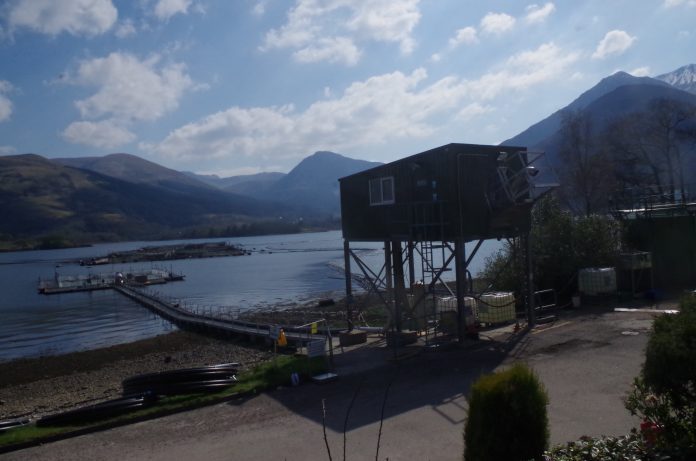Only one wellboat can get to Mowi’s Leven Seawater farm. And even when the “Ronja Commander” is able to, the tide can make it touch and go. But the site, with it’s older style square salmon farming pens is ahead of the pack when it comes to production.
Hundreds of cars take the Ballachulish Bridge that crosses the narrows between Loch Leven and Loch Linnhe, every day. While tourists take in the breathtaking Scottish scenery, many of them are oblivious to the number of headaches the bridge has caused wellboat operators.

High tide
Upon arrival, the sun shone brightly upon Mowi’s Loch Leven site, but the view was made more curious by a small green shed quite high up. Mowi communications assistant Jayne Mackay insisted that it was one of the company’s best-performing sites.

“The one boat that can get under it is the “Ronja Commander” and that’s only when it takes its mast down. And the tide needs to be under 3.2m high (at high tide). It’s not actually under the bridge which is the problem- it’s the leading to up to it. The operator has to get under it at 3.2 metres. If he doesn’t get back within the space of 3 hours – he then has to stay until the next high tide, which can be very costly to Mowi,” said farm manager Andy Martin.

Andy Martin looked quite familiar. Mackay explained that tghe farm manager had been featured on Lidl’s (a Mowi customer) recent campaign promoting Scottish salmon. “I never thought I’d be on a billboard when I started here,” laughed Martin, unsure of his new found fame as a “Loch Star”.
Billboards aside, Martin explained that he and his team – which includes fellow Scot and assistant manager Lewis Gibson – do onshore harvesting, sometimes of promotional fish for the Christmas and Easter markets.
Harvest
“We still do in the old style way,” said Martin, explaining the sites’ onshore harvesting method which involves swimming fish from one pen to the other with a mobile pen.
After the fish are moved, they are pumped up to the “little green shed,” said Martin pointing to it.

The shed in question is used every time they harvest the fish, acting as a compact version of Mowi’s harvest station in the port of Mallaig. The maximum the team will do each time is around 17 thousand fish – which takes eight to nine hours.
Flexible
“At midnight, there will be a team of four guys there and two guys at the bottom, including me. We will just stun and bleed them up there. We are self sufficiant here. The fish go straight into the lorry then onto Mowi’s Blar Mhor Processing Plant,” added Martin.

The farm manager said that while they do smaller harvests, they can be flexible if Mowi’s sales department needed an extra three thousand fish. “We can do it here, it doesn’t cost as much as we can do it without the wellboat,” he added.

